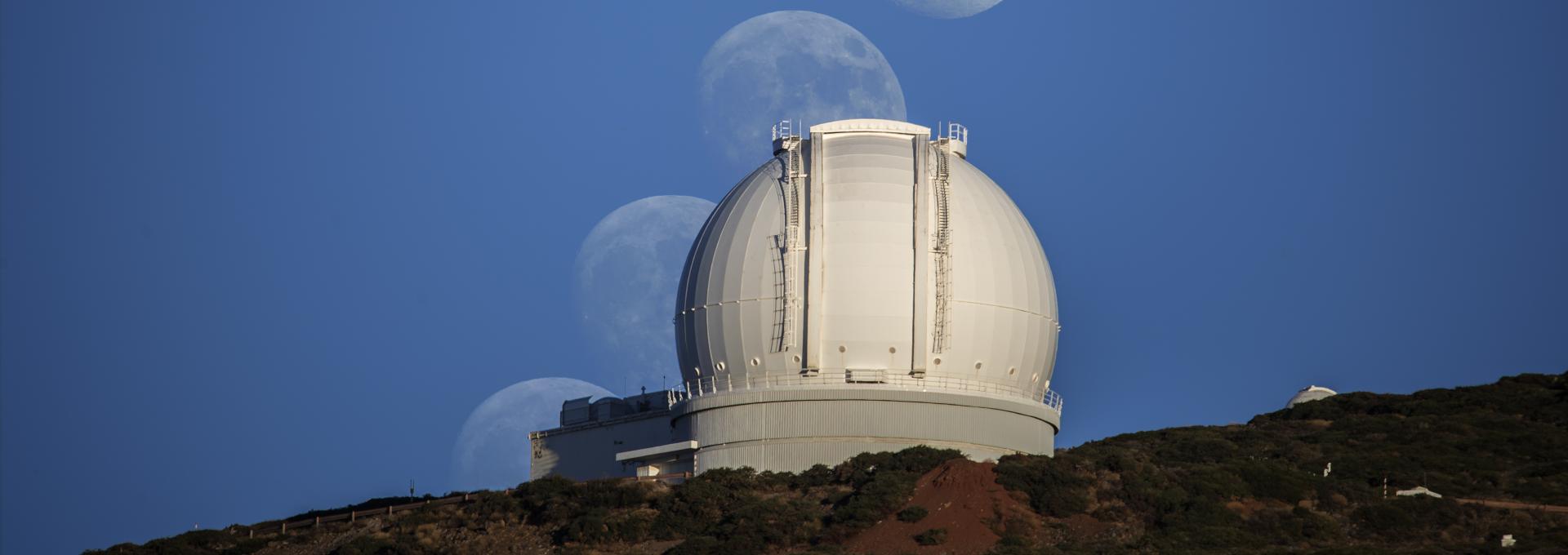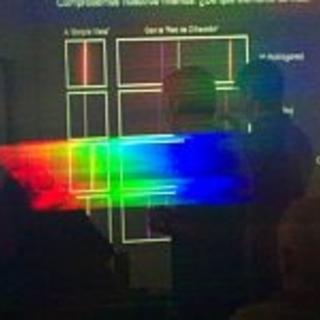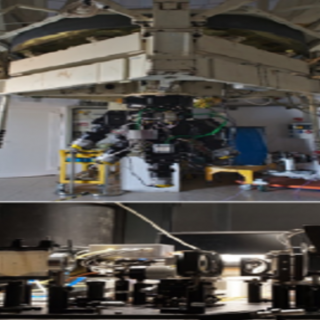William Herschel Telescope


The William Herschel Telescope (WHT) is the largest optical telescope of its kind in Europe, with a primary mirror of diameter 4.2 metres. Its versatile and state-of-the-art instrumentation together with the superb sky quality of the Roque de Los Muchachos Observatory have made the WHT one of the most scientifically productive telescopes in the world.
The WHT is part of the Isaac Newton Group of Telescopes (ING) that also operates the Isaac Newton Telescope. The ING is owned and operated jointly by the Particle Physics and Astronomy Research Council (PPARC) of the United Kingdom, the Nederlandse Organisatie voor Wetenschappelijk Onderzoek (NWO) of the Netherlands and the Instituto de Astrofísica de Canarias (IAC) of Spain.
The WHT is of classical Cassegrain configuration, with a paraboloidal primary mirror made of a glass-ceramic, Cervit, with nearly zero coefficient of thermal expansion, and coated with a thin layer of aluminum.
The effective focal ratio of the primary mirror is f/2.8, and the unvignetted field of view is 40 arcminutes. When not operating at prime focus, a convex hyperboloidal secondary mirror, made of Zerodur, 1.0 m in diameter, directs the light through a central hole in the primary mirror to the main instrumentation mounted at the Cassegrain focus beneath the primary mirror cell.
The telescope also incorporates a third mirror, a flat, angled at 45 degrees, which can be driven into position at the intersection of the axes, above the primary mirror, so that the light from the secondary is reflected sideways through one of the two altitude bearings to the Nasmyth platforms where large instruments can be placed. As required during the night, instruments mounted at any of these three stations can be selected within minutes by moving the 45-degree flat mirror.
The effective focal length of the telescope for the Cassegrain and Nasmyth foci is 46.2 metres (f/11). The WHT mounting is of alt-azimuth design, which requires full computer control of the motions in altitude and azimuth axes to track an object on the sky. The telescope weighs about 200 tonnes and is carefully balanced on hydro-static bearings to give the high precision motion that is required to track the stars.
The WHT's conception dates back to the late 1960s, when astronomers were wondering what kind of powerful telescope they should build in the northern hemisphere. The Science and Engineering Research Council (SERC) of the United Kingdom started to plan the WHT in 1974. The precise diameter of 4.2 metres was determined by the availability of the mirror blank, made by Owens-Illinois (USA). The mirror was figured at Grubb Parsons (United Kingdom). It is believed that this was the most accurate large mirror yet made at that time.
The advent of the WHT led SERC to negotiate a 20% participation by the Netherlands in 1981. That year was also the 200th anniversary of Herschel's discovery of Uranus, and the name of the new telescope was announced. Construction of the telescope building began in 1983 and first light on the telescope took place on 1 June 1987.
The WHT has played a central role in modern observational cosmology. Deep exposures taken by the WHT have led to the discovery of some of the most distant objects ever observed. The 'Herschel Deep Field', for instance, amounted to 70 hours of integration showing galaxies almost as faint as the famous Hubble Deep Field but over a 10 times larger area of sky.
For some time, astronomers considered using type Ia supernovae to determine the extragalactic distance scale. Supernovae of this type occur in the late stages of evolution of a binary system consisting of a white dwarf star orbiting a companion star. When the white dwarf mass reaches a critical value, the nuclear fuel ignites explosively, leading to an immense brightening of the star. The intrinsic luminosity of the explosion is thought to be independent of distance and therefore usable as a 'standard candle'. The distances and redshifts of these supernovae provide a measure of the deceleration parameter of the Universe and hence can be used to determine the ratio of the present density of the Universe to the critical density. Observations at the WHT of type Ia supernovae led in the 1990s to the discovery of the most distant supernovae ever observed, allowing astronomers to conclude that we live in an accelerating Universe, i.e. one that will expand with increasing velocity.
Other highlights include the first ever observation of the optical counterpart of a Gamma Ray Burst and the discovery of the first brown dwarf.

